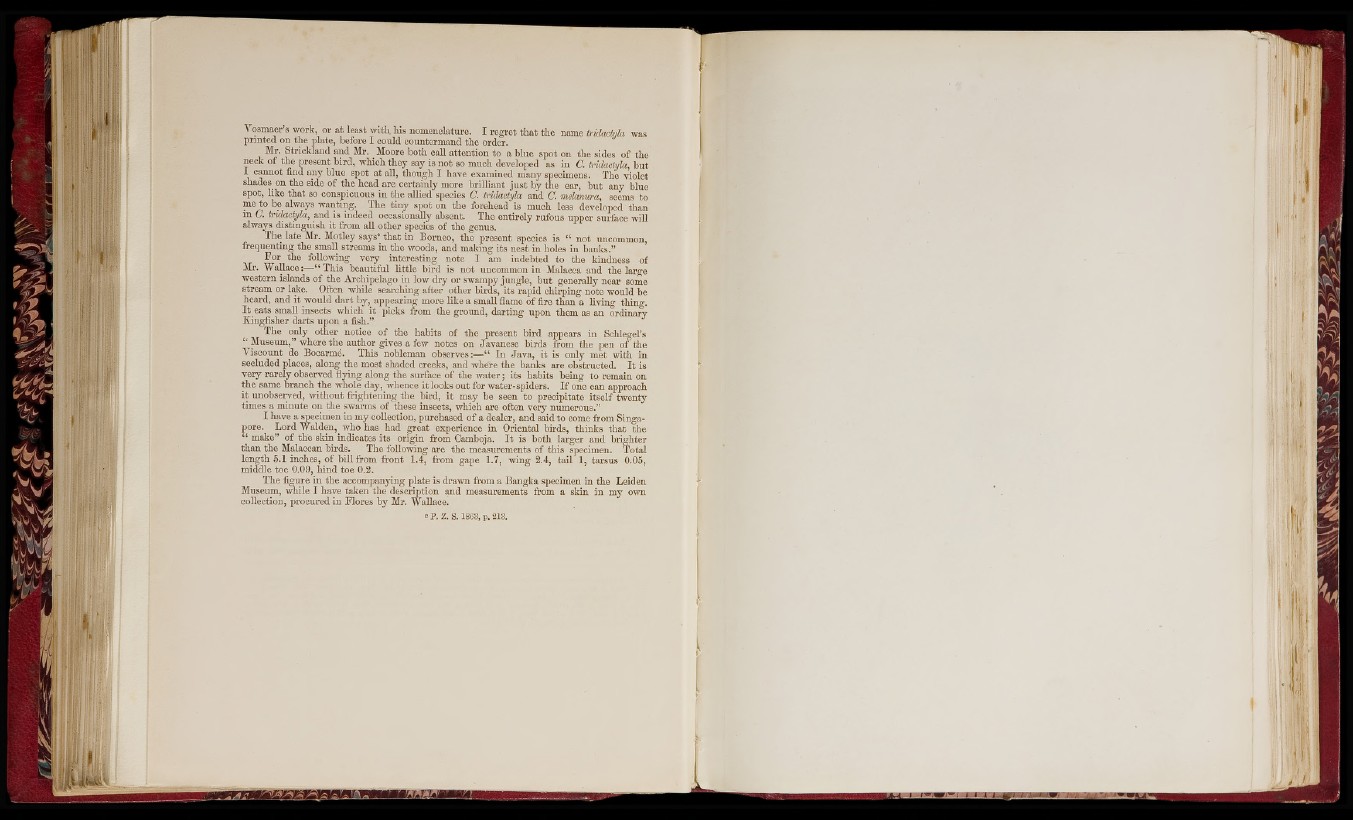
Vosmaer’s work, o r a t least w ith his nomenclature. I reg re t th a t the name tridactula was
p rin te d on th e plate, before I could cou n terman d th e order.
Mr. S trick lan d and Mr. Moore bo th call a tte n tio n to a blue spot on th e sides o f the
n eck o f th e p resen t b ird , which th ey say is n o t so m uch developed as in C ti'idactyla, b u t
I c an n o t find an y b lu e sp o t a t all, th o u g h I have examined many specimens. The violet
shades on th e side o f th e h ead a re c e rta in ly more b rillia n t ju s t by the ear, b u t any blue
spot, lik e th a t so conspicuous in th e a llied species C. tridactyla and C. melanura, seems to
me to be always wanting. The tin y spot on th e forehead is much less developed th an
in C. ti'idactyla, and is indeed occasionally absent. The e n tirely rufo u s u p p e r surface will
always d istin g u ish i t from a ll o th e r species o f th e genus.
'»''he late Mr. Motley says® th a t in Borneo, th e p resen t species is “ n o t uncommon,
CTYIo Li l-re v.rrerejre re.. .1 ---re l .l re re. ÍJ-*.____ L freq u en tin g th e small streams in th e woods, and m aking its nest 2i n 1h-o^ 1le__s_ _i_n__ 1b. an1k s.”,,
F o r th e following v e ry in to re stin g note I am indebted to th e kindness of
Mr. Wa llace:— “ This b e au tifu l little b ird is n o t uncommon in Malacca and th e large
western islands o f th e Archipelago in low d ry o r swampy ju n g le , b u t g enerally near some
stre am o r l ^ e . Often while searching a fte r o th er birds, its rap id ch irp in g note would be
/J ..U Jre..A 1-re- —rerere-rere-.ire-. _1171 7*7> .. 1« • jl*
heard, and i t wo u ld d a rt by, ap p earin g more like a small flame o f fire th a n a liv in ig g trnng.
th in g .
I t eats small insects which i t picks from th e g round, d a rtin g upo n th em as an o rd in arv
■.■■ ■■ r ------------------------------- gixxL.ix.-., x-tcciDiiAg irjjcj-Li 410 4411 oi'diuary
Kingfisher d a rts u pon a fish.”
T h e o nly o th er notice o f th e h ab its o f th e p resen t bird
b ird appe:
^ p ears in Schlegel’s
from th e pen o f the
“ Museum,” where th e a u th o r gives a few notes on Javanese birds fron
V isco u n t de BocarmA T h is nobleman observes:— “ In J a v a , it is o
--------------- — , on ly m et with in
secluded places, a long th e most shaded creeks, and where th e banks a re obstructed. I t is
v e ry ra re ly observed flying along th e surface o f th e w a te r ; its h ab its b e ing to remain on
th e same b ran ch th e whole day, whence i t looks o u t for w ate r-spiders. I f one can approach
i t unobserved, w ith o u t frig h te n in g th e bfrd, i t m ay be seen to p recipitate its e lf twen ty
tim es a m in u te on th e swarms o f th ese insects, which a re often v e ry num ero u s.”
I have a specimen in m y coUection, purchased o f a d ealer, and said to come from Singap
o re. Lo rd Walden, who has h ad g re a t experience in Orien ta l birds, th in k s th a t the
“ make” o f th e skin indica te s its o rig in from Camboja. I t is b oth larg e r and b rig h te r
th a n th e Malaccan birds. T h e following a re th e measurements o f th is specimen. Total
len g th 5.1 inches, o f b ill from fro n t 1.4, from gape 1.7, win g 2.4, ta il 1, tarsu s 0.05,
m iddle toe 0.09, h in d toe 0.2.
T h e figure in th e accompanying p late is drawn from a Bangka specimen in the Leiden
Museum, while I have taken th e d escription and measurements from a skin in my own
collection, p ro cu red in F lo re s b y Mr. WaUace.
c p . z . S. 18G3, p . 2